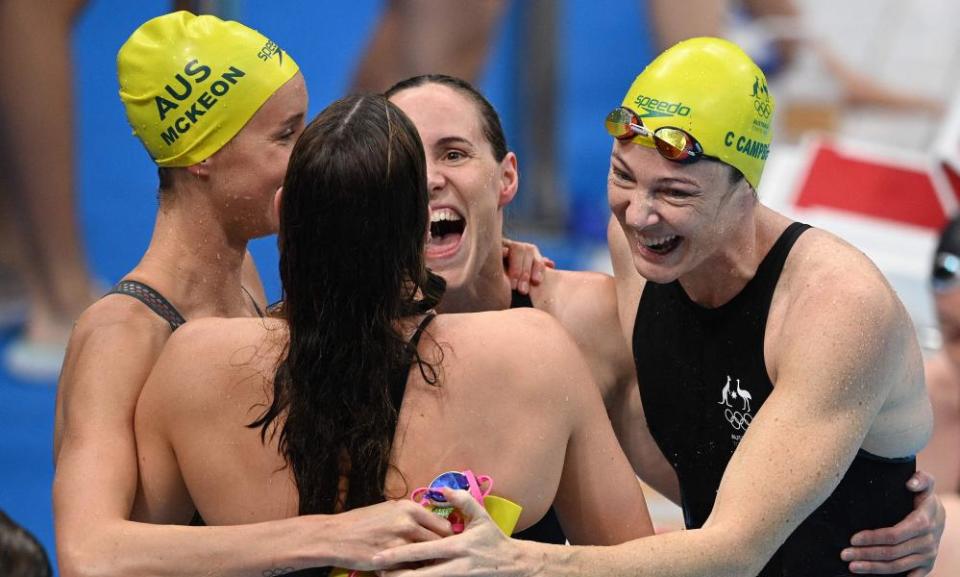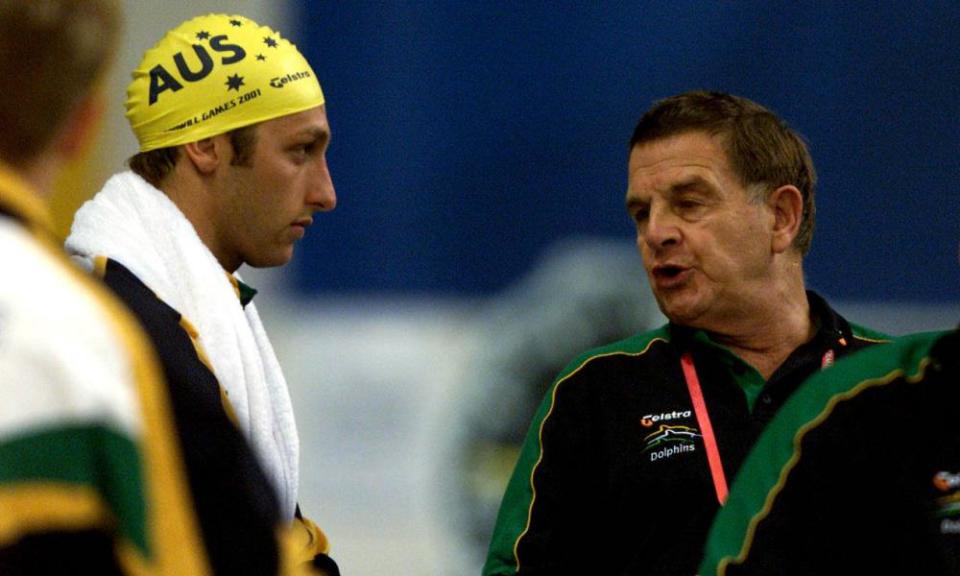Australian swimming’s ‘relay project’ that is paying off at Tokyo Olympics

Last Thursday, before Australia’s swimmers had swum any competitive laps in Tokyo, head coach Rohan Taylor outlined a key ambition. “There are seven relays that we compete in; there’s seven opportunities,” he said. At the Beijing Olympics in 2008, Australia had won a medal in all six relays. In Tokyo, continued Taylor, he wanted his swimmers to match that standard: “We are trying to put every single relay in a position to get on the podium.”
So far, so good. In the first relay event of the meet, the Australian women smashed their own world record to win the 4x100m freestyle. In the three relays that have followed – the men’s 4x100m and 4x200m freestyle, and the women’s 4x200m freestyle – the Australians have found themselves on the podium, collecting three bronze medals.
Related: Emma McKeon grabs gold as Australia enjoy more Olympic swimming success
“Relays to me are the greatest thing to be a part of,” Taylor said. “We’ve made [relays] a very big priority within our preparation.”
On Saturday, the Dolphins will be under pressure to continue the streak – as the mixed 4x100m medley relay makes its debut, the first-time a combined men’s and women’s relay event has featured at the Olympics. The Tokyo 2020 swim program will then conclude on Sunday with the 4x100 medley relay for both men and women. If the Australians can find themselves on the podium in all three, they will surpass their relay medal haul in Beijing. It would be quite the achievement.
But Australia’s success in Olympic relays is about more than just good fortune and fast individual swimmers. Relays are tactically complex, high-pressure events where the smallest mistake can lead to disqualification. Australia has responded by throwing time, money and dedicated research at the relay format, in the hope of boosting the nation’s swimmers to team glory. It appears to be paying off. These are Australia’s relay secrets.
--
Relays have long been a feature of the Olympic swimming program. At the 1904 Olympics in St Louis, the third modern Games, the men contested the 4x50 yard freestyle relay. It was replaced by the 4x200m relay in 1908, before the women had a 4x100m freestyle relay added to the program in 1912. In the subsequent century, both races remained an integral part of the Olympic swim meet (albeit with some gender discrimination – the women could not race the 4x200m until 1996). The 4x100 medley relay was added in 1960.

For Australia, relay swimming was not a priority. While an Australasian team (combining Australia and New Zealand) won the second-ever men’s 4x200m in 1912, it took four and a half decades for the nation to claim gold again – albeit twice, at the home 1956 Olympics. In the second half of the century, arch-rivals the United States reigned supreme in the relay. With the exception of a relay win under the Olympic flag at the boycotted 1980 Games in Moscow, Australia would not win another relay gold until the next home Games at Sydney 2000.
By then, Don Talbot was in charge, and the legendary swim coach had put a major focus on relay success. Following Talbot’s death last year, a swimming website headlined his obituary, “Legend Who Led Green & Gold Past Stars & Stripes”. This was true generally – Talbot was coaching the Dolphins when they famously surpassed the Americans in the medal tally at the 2001 world championships. But it was particularly true in the relay. Suddenly the United States had competition.
At the 2000 Olympics, Australia went five from six in the relays, including two golds. In Athens it was three from six, including two golds. After the high point of Beijing (six from six – two golds), Australia’s relay stars have continued to deliver. At London 2012 the Dolphins won four relay medals (one gold), in Rio it was five medals (again one gold). In Tokyo, the Australians want to go even better.
---
In recent years, the Dolphins have doubled down on their relay focus. “We run a relay project,” Taylor says at the midway point of the Tokyo 2020 meet. The project is led by Jessica Corones, performance solutions manager at Swimming Australia. “We’re built along relays – there’s where our depth is,” says Dean Boxall, an Australian swim coach who is leading the relay coaching in Tokyo. “We’re really trying to build that team unity.”
Australia’s swimmers, coaches and advisors point to four key factors driving Australia’s relay success.
First, the team gathers for a relay-focused training camps. “We come together at least once a year and train together for a full week,” Cate Campbell says after her 4x100m relay team had won gold on Sunday. “We push each other and we challenge each other, but we do that in a really supportive way. There’s no malice, and no animosity towards one another. I think that has just spoken volumes. This is the third Olympics in a row that Australia has won this event.”
Boxall makes us face the other way, and then calls ‘go’ for the swimmer coming in
Tamsin Cook
This year, that camp had added significance. “We did that in February on the Gold Coast, which was even more special this year than previous years because obviously we had the year apart with Covid,” says Kyle Chalmers, who has won two relay bronze medals so far this week.
Australia’s previous head coach, Dutchman Jacco Verhaeren, established the relay camps a few years ago. His successor, Taylor, has continued them. “It’s a good opportunity for us to race against each other … and practice those relay changeovers,” Chalmers says. “And then when the time comes, and it counts the most, we’re prepared and we’re not worried about the skills we need to do in the race.”
Relay technique is the second factor. The changeover between swimmers is all-important – if the incoming swimmer is too timid, they will lose valuable time. If they are too aggressive, they risk disqualification. Incoming swimmers cannot leave the blocks until their teammate has touched the wall; they are, however, given three one-hundredths of a second margin of error (on Wednesday, Australia almost lost their bronze medal in the men’s 4x200m when Zac Incerti dived in 0.03 seconds too early, but he was saved by this leeway).
The Dolphins have spent hours practising relay technique. “Our relay coach Dean [Boxall] gets us to do some pretty interesting drills,” says Tamsin Cook, who swam in the women’s 4x200m heat this week. “He makes us face the other way, and then calls ‘go’ for the swimmer coming in. We have to run, grab our goggles and make it back to the block to do a safe relay changeover. He throws everything at us so that when we hop out there we’re absolutely prepared for whatever happens.”
This preparation has included working on different relay starts. The tradition technique sees a swimmer with both feet on the front of the starting block. Even before their colleague has hit the wall, they lift their arms backwards and then forwards to gain momentum before their feet leave the block just as the outgoing swimmer touches home. But in recent years American swimmers have pioneered a new technique called the step-over start, which aims to give even greater momentum off the blocks, with one foot placed in front of the other.
Verhaeren was reportedly not a fan, but Taylor has encouraged his swimmers to go with their preferred approach. “We’ve given the athletes the opportunity to find what one suits them best,” he says. “We film it, we measure it, we look for what’s the best one. Some of them like the step-over, you’ll see Kyle [Chalmers] just does a two-foot start. So it’s a preference, it’s not a directive.”

The third factor is research. Swimming Australia has a team of analysts and sports scientists using video and timing date to inform relay strategy. “We have done analysis of the last 10 years of international 4x200m international freestyle relays,” says Professor David Pyne of the University of Canberra, who has attended four Olympics with the swim team (but is not in Tokyo). “The coaches have got all their experience – and everyone looks at the numbers – but we have done a deeper dive into the analysis.
“There has been a lot of work done on the order [of relay swimmers],” Pyne says. “It’s partly science and partly art. Normally you want your best swimmer to go first or last. That’s the conventional wisdom, which is what the research has borne out. The analysis we do is to help the coaches with their selections in race order. We’re also looking at rookie swimmers. There is some interesting analysis to show that the rookies can actually improve more [in relays]. It is a trade-off in risk. There is more potential to improve, but you don’t always get that in the emotion of the big moment.”
Even the best-laid strategies do not always go to plan. There was much controversy on Thursday morning when Australia finished third in the women’s 4x200m relay, having been expected to win. The team had swum fastest in the heats, but Taylor and Boxall swapped out the heat swimmers for an all-new final team. While the pair insisted they had no regrets in a combative post-race exchange with the media, the incident underscored the high-risk, high-reward nature of relay swimming.
---
The final factor is somewhat intangible. But the Australians are fortunate to have depth and breadth to their swimming program, and a seemingly endless conveyor-belt of new talent. And they also just seem to really like each other.
“They come together, they form a team,” Boxall says. “It’s like the transformers when they come together, the Autobots.” He points to the example of the men’s 4x100 team, who had not put in average times at the Olympic trials but improved to earn bronze in Tokyo.
“It’s very special to be part of this relay, it always is,” says Bronte Campbell, part of the gold medal winning women’s 4x100m team this week. “The competition in Australia is fierce for this relay, and that’s what makes us so competitive on the international stage. It’s more than us competing against each other for the spots on the relay, because we really are an extended team.”
McKeon, Campbell’s teammate, pointed to the talent coming through the ranks. “I think it’s the depth that we’ve got,” she says. “We race against each other all the time – [we] lift the standards, push each other and go faster and faster. We’ve got a lot of young ones coming through. They keep chasing the ones that are at the top, so that keeps the standard lifting all the time.”
All of which leaves Australia with the possibility of going seven out of seven in Tokyo. It will not be easy – the three remaining relays are all medleys, and Australia is weaker in the 100m breaststroke category for both men and women. But head coach Taylor remains optimistic.
“We still have some challenges,” he said mid-week. “We’ve got to figure out ways – that’s what we do, sit strategically [and put a team together] … I’m hopeful that we’ll go seven from seven.”

 Yahoo Sport
Yahoo Sport 



































































